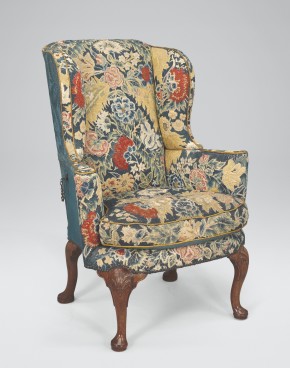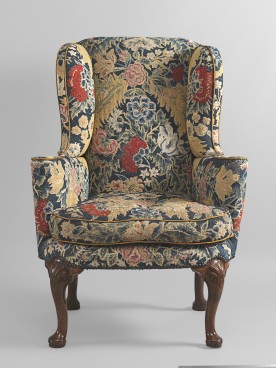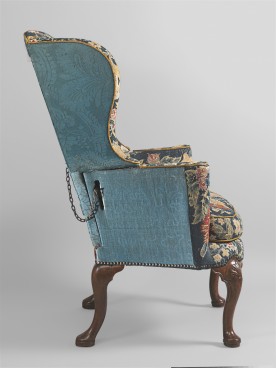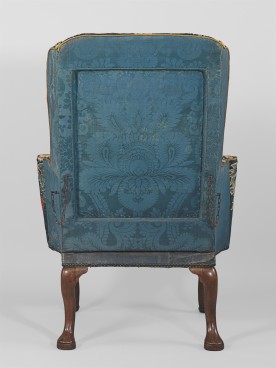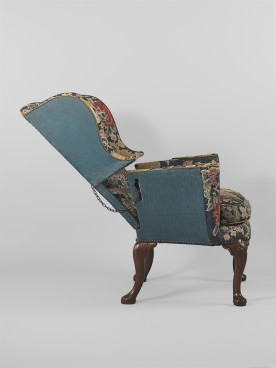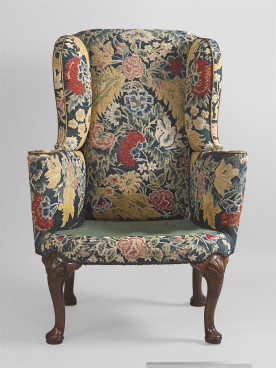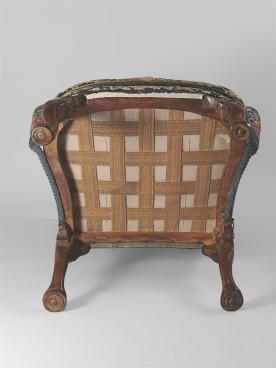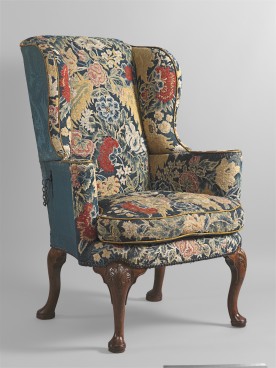Easy Chair, c.1730–40
Walnut, now with 18th-century needlework
The back is hinged at the base, allowing the chair to recline,
possibly for sleeping. This chair was formerly in the collection of
Percival D. Griffiths (1862–1937).
Adam Bowett Catalogue
Description
An upholstered easy chair, circa 1730-40. The inside of the chair – back, cheeks, arms, seat front and cushion – is covered in rich floral needlework. The back is roughly rectangular, with curved cheeks or wings and flared sides, over a flared seat with loose cushion, and raised on shell-carved cabriole forelegs with pad feet, the back legs also of cabriole form with pad feet. The back is hinged at the base and reclines, together with the cheeks, by means of two curved iron armatures which locate inside the sides of the chair and are adjusted and fixed by means of an iron pin retained by a chain.
Dimensions
H: 45” (115cm) Seat height: (without cushion) 15 ½ ” (39cm) W: 32” (81cm) D: 30” (76cm)
Materials
Walnut, beech, softwood? (this last is conjectural because the chair’s upper frame is enclosed by upholstery).
Dating
Easy chairs were first developed in the 1690s, and arrived at their mature form in the early Georgian period. The pad feet and shell carved knees suggest a date range of 1730-1740.
Construction
Construction of the back and arms is largely conjectural because enclosed by upholstery. The seat rails are beech, probably mortised-and-tenoned into the tops of the fore and back legs; all four legs have supporting brackets of walnut nailed in place.
Marks or Stamps
None
Condition
Condition of most of the frame is conjectural because enclosed by upholstery. However, there are flight holes of furniture beetle at the base of both outside cheeks suggesting historic worm infestation which is also evident in the seat rails. All four feet were originally fitted with castors, the circular recesses now filled with softwood and applied with metal domes or gliders. The outer faces of both rear feet have applied sections, possibly original, but perhaps repaired. The support blocks at the tops of the legs were probably originally glued but are now nailed. The junction between the front left leg and the seat rails has been heavily damaged and repaired and at one time had additional blocks or braces applied, now removed. There are five iron sprigs driven in to the underside of the rear seat rail and two more to the right seat rail, there were presumably two more sprigs on the left. These were intended for a fitted loose cover now missing. The upholstery is unlikely to be original, although the seat webbing is eighteenth century and may be original to the chair. See also separate textile conservation report.
Additional Remarks
The evidence of the sprigs, which acted as fixing points for a fitted loose cover, raises an interesting question. If a loose cover was fitted, how was the back reclining mechanism operated? Clearly, if the cover was in one piece, the back could not recline. Perhaps it was made in two parts, one fitted to the back and one to the lower sides and seat.
It is possible that the chair’s original covering was quite modest, perhaps a camlet or other woollen cloth, and that the loose cover was made of a more showy material such as damask. This seems to have been the system used at Erddig. On the other hand, a set of chairs and settees at Ham House have figured velvet covers, clearly expensive, which suggests that their loose covers were more modest, everyday affairs (illus. Bowett (2009), p. 167).

